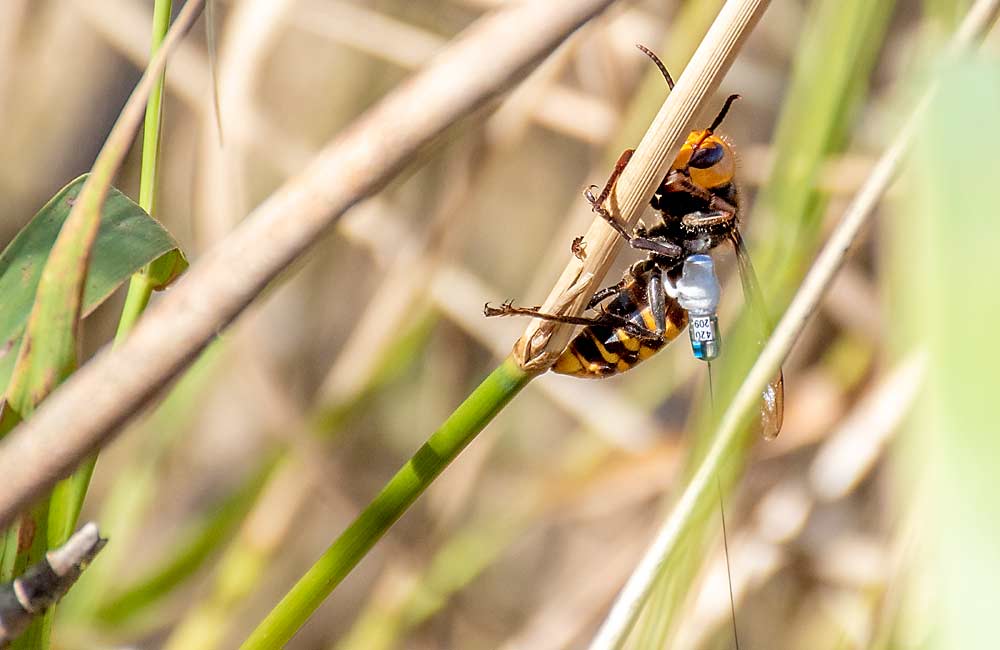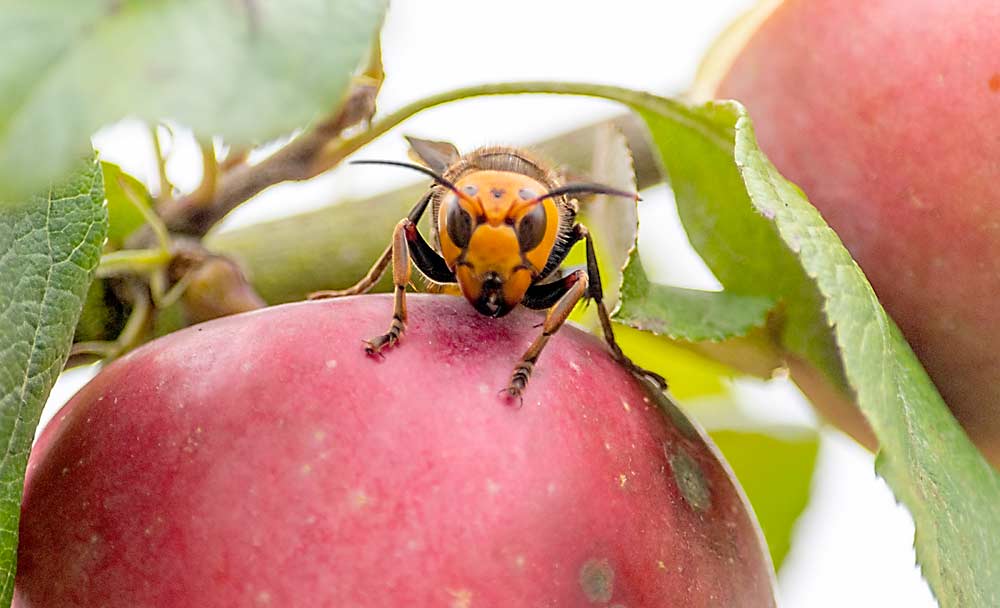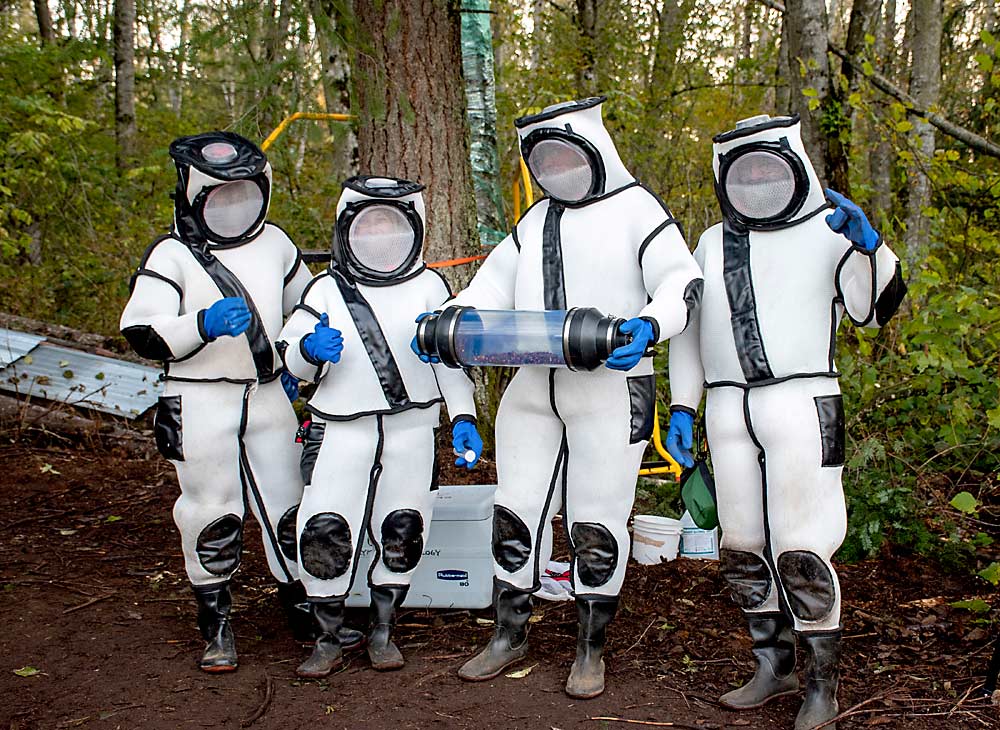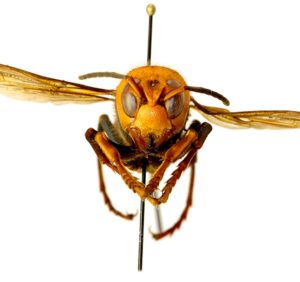
The fight to eradicate the Asian giant hornet before it is established in North America notched a major victory last fall, when researchers found a nest just before the next generation of queens dispersed.
“It seems like we got there just in the nick of time,” said Sven-Erik Spichiger, state entomologist with the Washington State Department of Agriculture. That stopped up to 200 new queens from attempting to establish new nests this year in the northwest corner of Washington state.
The hornet, which poses a threat to both honey bees and people, was first detected in late 2019 in Whatcom County, Washington, and across the U.S.-Canada border in British Columbia. Last year, entomologists launched a campaign to trap, track and remove the hornets to prevent the dangerous insect from making itself at home in North America.
“These are severe pests for managed honey bees that are pollinators for much of our agriculture,” Spichiger said. “I’m cautiously optimistic that we are kind of ahead of this. I think we still stand a really good chance of keeping this out.”
But he believes, based on trapping data, that another nest or two likely escaped detection last year. In British Columbia, provincial apiculturist Paul van Westendorp suspects, based on sightings, several nests on the Canadian side of the border survived, as well.
So, entomologists in Washington and British Columbia are gearing up to put everything they learned about the Asian giant hornets in 2020 to use again this season.
Trapping and tracking
To destroy hornet nests, you first have to find them.
With the help of citizen scientists, WSDA relied on a network of low-tech traps made from plastic bottles baited with orange juice and rice wine, said agency spokesperson Karla Salp.
“Having those traps out really helps us identify the area to focus on,” she said. And the good news: The 31 confirmed detections suggest the hornet has not expanded much beyond the Blaine, Washington, area where it was first reported in 2019.

But the hornets drown in those traps. To find the nests, the scientists needed to track a live hornet to its home. That requires developing a trap to catch live hornets and a tracking device that can be affixed to them.
For more attractive lures, the WSDA turned to scientists at the U.S. Department of Agriculture’s laboratory in Wapato, Washington. Jackie Serrano, a USDA research entomologist, joined the lab to work with chemical ecologist Peter Landolt, who worked on wasp lures throughout his career until his retirement in 2018. The WSDA reached out to Serrano for help trapping the Asian giant hornets, and she began to create compounds based on what “we know to be attractive to other vespids,” Serrano said.
Her lures were out all summer and fall, placed in live traps near reported sightings, but interestingly, the compounds did not start working until later in the fall, she said. Just as yellow jackets start to swarm picnics in the late season, what attracts the hornets can change through the year.
This year, she plans to continue looking at lures that may work for worker hornets earlier in the season and also lures that will attract the new queens when they disperse.
“It started out as a side project and now it’s all-consuming,” Serrano said. “We’re learning as we are going.”
Nest surprise
Last October, the WSDA finally caught several live hornets to attempt to track them. Scientists chilled the hornets briefly to calm them, then attached tiny radio tracking tags. After recovering with a snack of grape jelly, one flew back to its nest, leading the team to a large tree in a rural backyard.
“They almost always nest in the ground, so we were pretty surprised to realize that they were 8 feet up in the tree,” Salp said.
The WSDA’s response went viral: Scientists in hornet-proof space suits carefully sealed up the tree and used a vacuum collector to suck up the worker hornets who flew out to attack them. Then the nest was filled with carbon dioxide, with the intent of killing the hornets that remained inside.

A few days later in the lab, when researchers cut into the nest for examination, they discovered many of the hornets inside had survived, including unmated queens.
That was yet another surprise.
“The nest was capable of producing 200 queens, and 76 had emerged sometime between when we did the extraction” and the examination of the nest, Spichiger said.
Queens usually spend a few days around the nest after they emerge, mate, and then spend the winter in diapause. “In theory, they wake up in the spring and a small percentage go on to found new colonies,” he said. “If your mated Asian giant hornet queen picks a nice protected area, it doesn’t matter how cold it gets, they can make it through the winter just fine.”
Very few queens escaped before the nest removal, he said, but it’s unknown how many might have been produced by other nests, if any, that went undetected.
One last surprise is good news: There were no reported honey bee hive attacks in 2020, after at least four in the fall of 2019, Salp said.
“To me that was one of the most surprising things is that there was no reported hive attack last year,” she said. Perhaps they found the nest before the workers went into their seasonal “slaughter phase,” she said, but it’s one of many questions scientists have about how the hornets will behave in this new environment.
“Last year, we just learned so much, but I think there is still going to be a lot of that happening over the next few years,” she said. “It’s hard to be in that position of learning things through trial and error. … No one has ever done it before.” •
—by Kate Prengaman







Leave A Comment